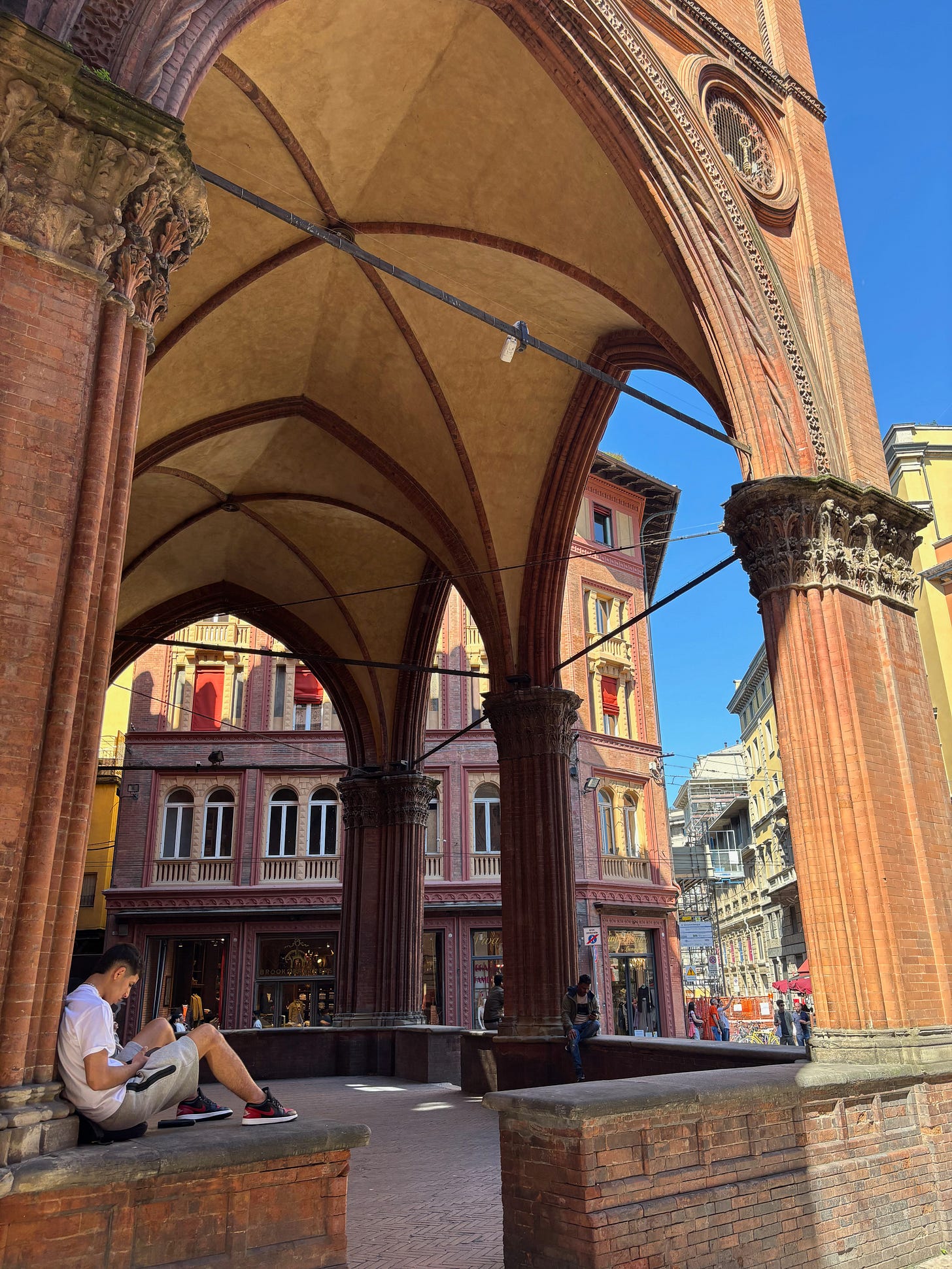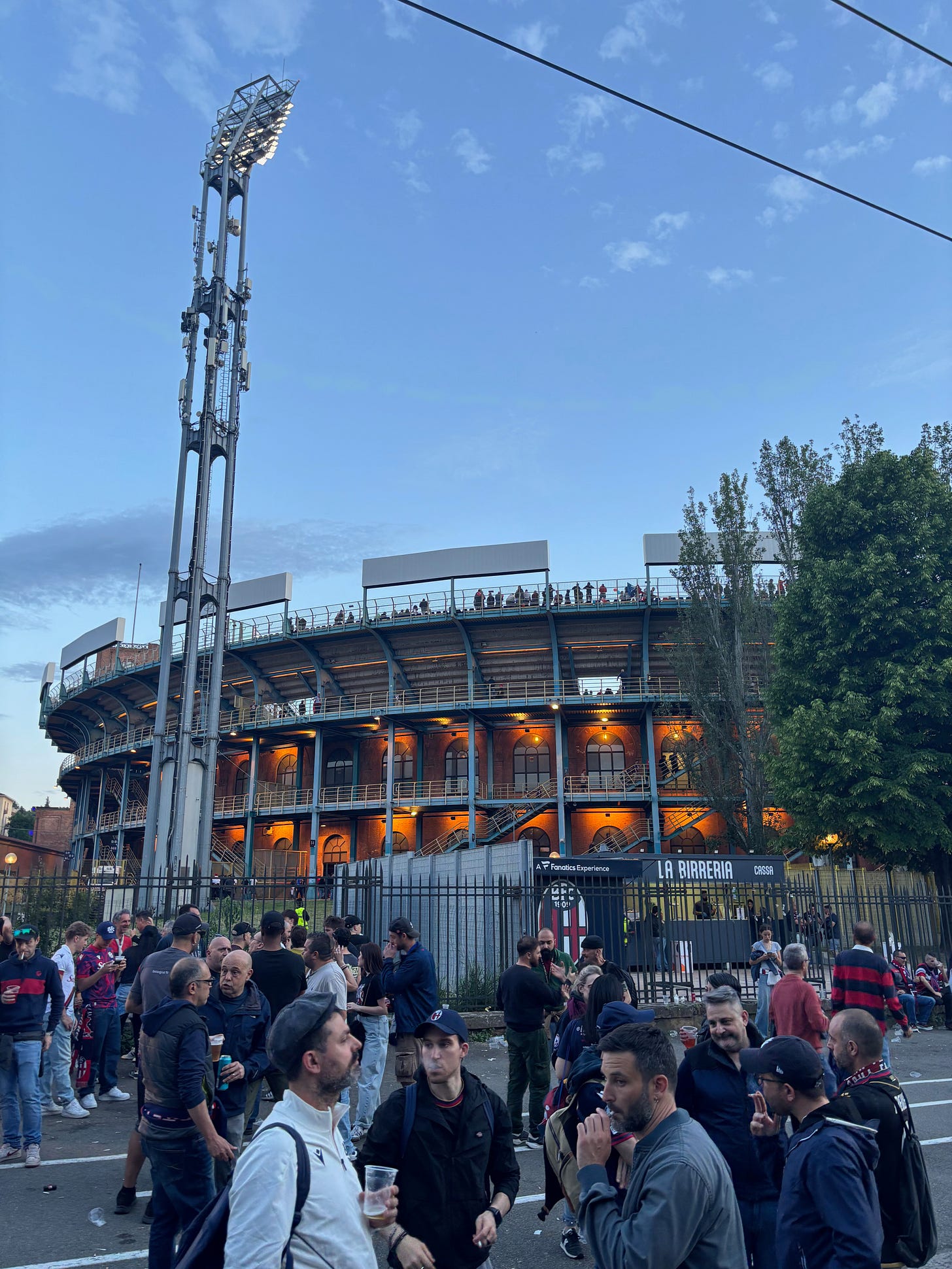This is an excerpt from a piece by Jack Holmes of THE FOOTBALL WEEKEND.
Like any city with ancient roots, Bologna has its layers. It’s been invaded a lot. It was Etruscan, then some Celtic tribes got hold of it, then it was taken by the Romans. The latter’s first order of business when conquering a new chunk of territory was to build a big road through it, and when they took this area of northern Italy around 189 BC, they built the Via Aemilia. It lends this modern region of Emilia-Romagna its name.
There are a great many towns along the ancient highway, among them Parma and Modena and Reggio Emilia, birthplace of Renato Dall’Ara. But Bologna is the capital of this territory, because after it changed hands a few more times — it was repeatedly sacked by the Goths and controlled for longer by the Lombards — Charlemagne came to town by request of Pope Adrian I at the dawn of the Middle Ages. The Frankish king sorted those Lombards out and seized control of what’s now northern Italy in an important step on his path to becoming what would later be known as “Holy Roman Emperor.”
Many of his successors spent time fighting for control of this area with subsequent popes who were less pleased with the whole power dynamic. Bologna’s noble families chose sides in these perennial disputes, lining up as “Guelfs” and “Ghibellines,” all while the city was rising to become one of the most important in medieval Europe. These families built soaring stone towers for defense and to display their wealth and power, the world’s first skyscrapers, and some of them still stand today in a city center that is remarkably preserved. Most of these torri date from the 12th century, not long after the University of Bologna — the world’s oldest — opened its doors.
“Bologna is a university city,” says Olivio Romanini, the caporedattore — editor-in-chief — of the Corriere di Bologna. “It’s one million people in the metropolitan area, but it’s bigger, it’s more [than that].” It attracts students from all over Italy and the world.
“That gives us a good energy,” Graziani said, “new ideas, new people, movements, music, literature, cinema, art.”
It’s also a crossroads: “It’s in a position [on the peninsula] where everyone passes through Bologna to go to the North, or to the South,” Romanini said. If all roads lead to Rome, they go through Bologna. Many northern cities (outside of Milan) are fairly sleepy, but not this one. “It’s the Napoli of the north. It’s not a boring city,” he said.
Most of all, though, it’s where so many epochs meet, chiefly the medieval and the modern. The stone streets and sweeping palazzos and giant timber beams supporting 800-year-old bricks are a time machine to the days of dukes, fiefdoms, warrior popes, and yes, serfs. Apart from the towers, the most distinctive feature of this medieval world are the portici, the porticoes that line nearly every building in sight — even some from the modern era — that have been designated a UNESCO World Heritage Site for the singular character they offer the city.
The most famous are the portici of San Luca, nearly four kilometers of patterned stone archway that climb up a hill to the Sanctuary of the Madonna di San Luca, just southwest of the city center. And at the foot of the hill, built into the porticoes as they pass on by, is the Stadio Renato Dall’Ara. Because those that built the stadium had a very clear idea of what they’d like to connect it to.
Before kickoff, supporters might get a beer at Pub Number Ten on the Via Emilia, or at Bar Dalla on the Via Andrea Costa quite a bit closer to the ground. They might also get a bite in what is, after all, the Italian gastrocapital. “If the match is in the afternoon, we will get a plate of tortellini,” Romanini said. Others might get a drink or something to eat at one of the street trucks on the blocks adjacent to the stadium.
There, crowds of blue-and-red-clad men smoked cigarettes and vapes in loose circles with the sky blue-and-yellow metalwork of the stadium exterior rising up behind them as the sun slid down. The minutes ticked away, and the crowds started funneling towards the gates. I joined the parade down the Via Pietro de Coubertin towards the Torre di Maratona and Distinti. In front of the tower, you’ll find the famous rows (and rows) of motorbikes from the pictures, and on either side, people line up in the porticoes to get their tickets scanned and enter.
Inside, there are cavernous, barrel-vaulted brick ceilings high above the crowd of Felsinei traveling in all directions. I picked my way through, choosing to head towards the field first and up the stands. I passed groups of three or four greeting each other jovially on the concrete staircases before I found my seat near the top. There was a buzz around the place, Bologna fans and undercover Juve partisans chatting excitedly ahead of a very big game. Two young kids next to me in Bologna hats gesticulated wildly as the announcer read the lineups. And then, soon enough, the pageantry began. The club anthem, “Le Tue Ali Bologna” — “Your Wings, Bologna” — rang out, and plenty sang along lustily as, out in the distance, the flares burned red in the Curva Bulgarelli.
“Bulgarelli” refers to Giacomo, the legendary midfielder born in the commune of Medicina outside Bologna who played his whole career for the club. He served this institution for 16 years and captained Bologna to the Scudetto in 1963-64. He still holds the club record for appearances with 470, and now his name is immortalized on the Curva. But Graziani doesn’t call it the Bulgarelli.
“Andrea Costa was one of the first sindicalisti” — trade unionists — “in Italy,” he said. “He born in Imola, a few kilometers outside Bologna” along the Via Emilia. Now his name’s on another road, one that runs west from the city center and past the Stadio Renato Dall’Ara, behind the stand where Marco and the ultras sit. “For anyone old enough to remember, it’s the Curva Andrea Costa,” he said. “The Old Guard says Curva Andrea Costa. It's something you can’t change. It stays with us.”
Costa was one of the founders of the Italian socialist movement, having begun his political life as an anarchist and a genuine revolutionary. While he was imprisoned for a failed insurrection amid the financial meltdown following the Panic of 1873, he remade his philosophy and gravitated towards legal means, eventually winning election as Italy’s first socialist parliamentarian. He remained a staunch advocate for strike actions and trade unions, though, and became a national labor leader. 115 years after his death in 1910, Costa is still central to this town’s narrative.
“Bologna is basically a left-wing city,” Romanini said. “For years, it was the capital of the Italian left. It is called, ‘The Fat, the Learned, and the Red,’ and therefore it’s a contradiction that its stadium is of fascist origin.”
The Stadio Renato Dall’Ara was initially known as the “Littoriale,” as in “fascio littorio,” referring to the symbol of ancient Roman judicial authority that was adopted by Benito Mussolini and the National Fascist Party. The stadium was a project of Leandro Arpinati, one of Mussolini’s earliest political collaborators who led one of the first fascist paramilitary squads in an attack on socialists and others in and around Bologna’s Piazza Maggiore. It was known as “the strage” — massacre — “of the Palazzo d’Accursio.” Arpinati was elevated to the party hierarchy after the March on Rome in 1922, and he became (among other things) mayor of Bologna and president of the Italian football federation. But the Littoriale was part of a grand multi-purpose sporting complex that also included tennis courts and swimming pools, and some of those facilities are still there today.
The project was such a priority for the party that King Victor Emmanuel III visited in 1925 to mark the laying of the initial foundations, and Mussolini came to town on a white horse in 1926 to inaugurate the stadium. (Bologna did not start playing football matches there until the following year.) The next day, Il Duce was celebrating the fourth anniversary of his rise to power with a parade through the city center when a 15-year-old named Anteo Zamboni was accused of trying to assassinate him. The attempt did not succeed, and the teenager was promptly lynched by the squadristi led by Arpinati, though there’s still a street nearby the site — the Via Zamboni — named after him.
“The first day of life of the Dall’Ara stadium is the day with the shot,” Romanini said. But Mussolini survived, and his reign as dictator was a glorious time for Bologna. They won six of their seven league titles, two of them under head coach Árpád Weisz, a Hungarian Jew who was forced to flee the country for the Netherlands with his wife and two children following the enactment of the Italian Racial Laws in 1938. In 1944, they were captured by the Nazis, and all four were murdered at Auschwitz. The Curva San Luca at the Dall’Ara was formally renamed in his honor in 2018.
But long before that, in Bologna’s heyday, there was a statue of Mussolini on horseback commissioned to commemorate his visit that was placed in the stadium’s tower. It stood until he was deposed in 1943, when it was torn down and the ground was renamed the Stadio Comunale. But the tower remains, hooked into the portici that link Bologna to its medieval past, just as The Leader and his lieutenants intended.
Much like the Via dell'Impero that he built to connect the Monumento Vittorio Emanuele II in Rome to the Coliseum and all the ancient empire’s glories, so was this grand building fused to Bologna’s heavyweight history. The Littoriale had design elements cribbed from the Coliseum, too, with the rows of archways ringing the exterior at each level. The intent was clear: to build a monument to physical strength and hardened beauty that was worthy of what these dark and wicked men thought would be just the latest period of civilizational greatness on the Italian peninsula.
MTAG Notes
It has been another special season for Bologna.
They won the Coppa Italia, beating Milan in the final last month. It marked their third title in the competition, but their first in 51 years.
A ninth-place finish in Serie A was a disappointment, given Bologna were well in the running for Champions League qualification for much of the campaign, yet they will be guaranteed Europa League football next season due to their Coppa triumph.
They have some impressive players, too.
Dan Ndoye is a superb talent, capable of playing on either flank. He chipped in with 15 goal involvements in all competitions.
Their star man is Italy international Riccardo Orsolini — he scored 17 goals. Santiago Castro is a highly rated prospect who has a bright future.
Midfielder Lewis Ferguson is another Scot thriving in Serie A.
Vincenzo Italiano, who enjoyed a strong spell in charge of Bologna’s rivals Fiorentina, has shrugged off any doubts and at least equalled the efforts of Thiago Motta.
The Champions League was just a touch too far for Bologna in 2024-25, but the Europa League should represent a better chance for a deep run, and for this team to continue this great city’s footballing renaissance.
All photos credited to Jack Holmes









Great piece